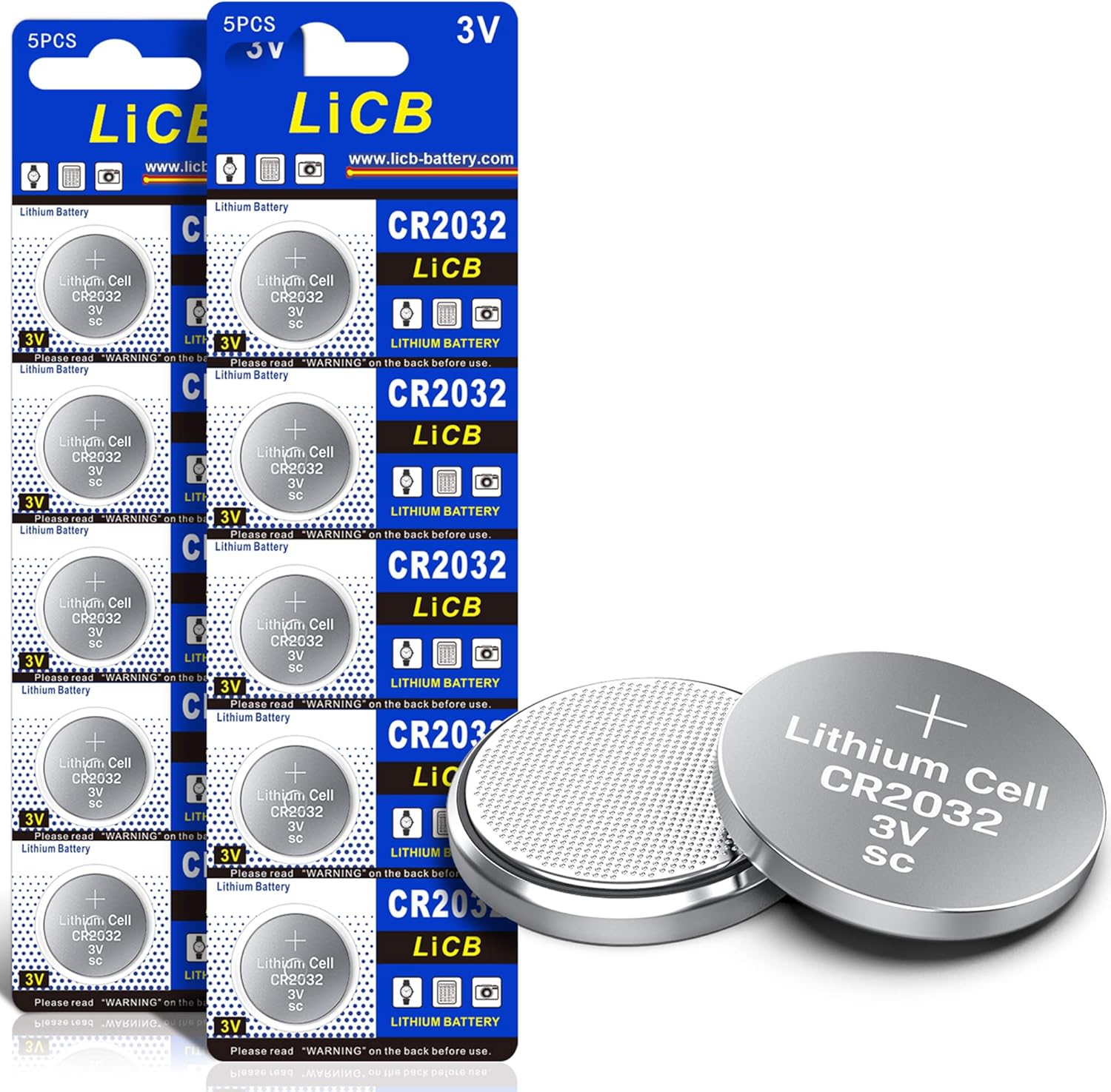
CR2032 Battery: A Comprehensive Guide
CR2032 battery is a widely recognized type of lithium coin cell battery that plays a crucial role in powering various small electronic devices. Its designation, ‘CR2032’, consists of the ‘CR’ prefix and a numerical code that describes its physical dimensions. The ‘C’ in ‘CR’ denotes a lithium chemistry, while the ‘R’ stands for round, indicating its circular shape. Specifically, the ‘2032’ part of its name refers to its diameter of 20mm and a height of 3.2mm, making it a compact and convenient power source.
These batteries are predominately composed of lithium, which is known for its high energy density and long shelf life. This makes the CR2032 an ideal choice for devices that require a reliable power source without the need for frequent replacement. Typically, the CR2032 battery features a voltage of 3 volts, providing a consistent and stable energy supply for various applications. Its remarkable properties enable it to maintain performance over extended periods, often lasting several years in devices such as watches, calculators, and remote controls.
In terms of construction, the CR2032 battery consists of a cathode made from manganese dioxide, an anode composed of lithium, and an electrolyte that facilitates ion transfer between the two electrodes. This configuration allows the battery to deliver energy efficiently while minimizing self-discharge rates. Due to its ubiquity and compatibility with numerous devices, the CR2032 battery has become one of the most prevalent lithium coin cells on the market, providing a practical solution for powering a wide range of electronic products.
Common Applications of CR2032 Batteries
The CR2032 battery, a widely recognized coin cell, is utilized in numerous devices across various sectors due to its compact size and reliability. One of the most prevalent applications for CR2032 batteries is in wristwatches. The minimal dimensions of these batteries make them an ideal power source for timekeeping devices, ensuring that users have a lightweight and durable watch that requires infrequent replacements.
Another common use of the CR2032 battery is in calculators. These devices benefit from the battery’s long shelf life and stable voltage output, enabling users to perform calculations without interruptions. These batteries power not just simple calculators but also more complex scientific and graphing calculators, facilitating the efficient functioning of educational tools.
In addition to personal electronics, CR2032 batteries are frequently found in remote controls. From televisions to garage doors, this battery type provides the essential energy needed to operate these devices seamlessly. The low self-discharge rate of CR2032 batteries ensures that the devices remain functional over extended periods, even when not in use.
Medical devices also rely on CR2032 batteries for their operation. Common applications include glucose meters and heart rate monitors, where precision and reliability are critical. The power capacity offered by these batteries enables consistent performance, ensuring that users have access to accurate health monitoring.
Furthermore, CR2032 batteries are employed in various other electronics, including toys, sporting equipment, and home automation systems. This versatility is attributed to the battery’s ability to deliver consistent voltage while maintaining a compact form factor. The continued use of CR2032 batteries across these applications highlights their importance in modern technology, providing reliable power solutions for both everyday and specialized devices.
Key Specifications and Features
The CR2032 battery is a coin cell lithium battery widely utilized in various electronic devices, ranging from wristwatches to computer motherboards. Its technical specifications are crucial for understanding its performance and suitability for different applications. The standard voltage of a CR2032 battery is 3 volts, which is critical for powering devices that require consistent and reliable energy supply.
Another important specification is the battery’s capacity, typically measured in milliamp-hours (mAh). A standard CR2032 battery usually boasts a capacity ranging between 220 and 240 mAh. This capacity determines how long the battery can effectively power a device before requiring replacement. The discharge rate is also a significant aspect, as it indicates how quickly the battery can deliver energy. For many applications, the CR2032 provides a steady discharge rate, ensuring that devices function optimally throughout their intended lifespan.
Shelf life is another key consideration, with most CR2032 batteries having a shelf life of up to ten years when stored under proper conditions. This longevity makes them an ideal choice for devices that may not be used frequently, as they retain their charge for extended periods. Environmental factors such as temperature and humidity can affect battery performance; CR2032 batteries typically operate effectively in a temperature range of -20°C to +60°C. However, extreme temperatures can lead to decreased efficiency and shorter operational periods.
In summary, understanding the specifications and features of CR2032 batteries—such as voltage, capacity, discharge rates, and environmental tolerance—is essential for selecting the right battery for your devices. These technical details ensure users can rely on the CR2032 to meet their energy demands effectively.
Advantages of Using CR2032 Batteries
The CR2032 battery has gained significant popularity due to its numerous advantages, making it a preferred choice for both manufacturers and consumers. One of the primary benefits of this battery type is its reliability. With a stable voltage output and consistent performance, CR2032 batteries ensure that devices function properly over an extended period. This reliability is particularly important in applications such as watches, calculators, and remote controls, where dependable power is essential.
Another noteworthy advantage is the impressive shelf life of CR2032 batteries. These batteries can maintain their charge for several years when stored properly, which allows consumers to stock up without worrying about rapid depletion. This long shelf life not only contributes to convenience but also reduces the frequency of battery replacements, ultimately saving time and resources.
Additionally, CR2032 batteries are lightweight and compact, making them ideal for devices where space and weight are critical factors. Their design accommodates various applications, from small electronic devices to larger, more complex systems. Consumers appreciate the portability that these batteries offer, as they can easily be carried for emergency use or replacements.
CR2032 batteries also exhibit a broad operational temperature range, enhancing their versatility in different environments. They can perform well in both high and low temperatures, making them suitable for use in outdoor devices and varying climate conditions. This adaptability contributes to their widespread acceptance among manufacturers, as they can design products that will operate effectively for users regardless of their location.
In summary, the CR2032 battery offers numerous advantages, including reliability, a long shelf life, lightweight design, and the ability to function across diverse temperature ranges. These factors combined make it an appealing choice in various consumer electronics and a product that many manufacturers trust for their designs.
Limitations and Disadvantages
While CR2032 batteries are a popular choice for various electronic devices, they are not without their limitations and disadvantages. One primary drawback is their energy density. Compared to other battery types such as lithium-ion or nickel-metal hydride, the energy capacity of a CR2032 battery is relatively low. This means that in applications requiring larger energy outputs or longer runtimes, reliance on CR2032 batteries could lead to more frequent replacements, which may be inconvenient and costly over time.
Another concern surrounding CR2032 batteries is their environmental impact, particularly regarding disposal. Coin cell batteries contain toxic materials that can be harmful if not disposed of correctly. Recycling programs for batteries vary significantly, and improper disposal can lead to soil and water contamination. Therefore, it is essential for users to be aware of local regulations regarding battery disposal and recycling to mitigate environmental harm.
Furthermore, CR2032 batteries are susceptible to leakage and short-circuiting if not used properly. Overextending the lifespan of a battery beyond its recommended usage can result in leakage of the battery’s contents, which are corrosive and potentially damaging to devices. Additionally, if these batteries are exposed to extreme temperatures or humidity, their performance can significantly degrade, leading to increased risks of leakage and hazards associated with short-circuiting. Consequently, it is vital for consumers to follow product guidelines and manufacturer’s recommendations to ensure safe and effective use of CR2032 batteries.
How to Properly Store and Maintain CR2032 Batteries
Storing and maintaining CR2032 batteries effectively is crucial for ensuring optimal performance and extending their lifespan. These coin cell batteries are commonly used in various devices, such as watches, calculators, and remote controls, which makes understanding their storage requirements essential.
One of the primary factors to consider when storing CR2032 batteries is temperature. It is advisable to keep the batteries in a cool, dry place, ideally between 15°C to 25°C (59°F to 77°F). High temperatures can cause the batteries to leak or become less effective, while excessively low temperatures may lead to reduced performance. Moreover, exposure to direct sunlight or extreme heat, such as that from a fireplace or radiator, should be strictly avoided, as it can degrade the battery components.
Humidity is another critical aspect that can affect the longevity of CR2032 batteries. Keeping batteries in a humid environment may lead to corrosion and degradation of the cell’s materials. Therefore, it is best to store them in airtight containers or original packaging to minimize exposure to moisture. Furthermore, ensuring that the storage area has adequate ventilation will help maintain a stable environment for the batteries.
Aside from environmental conditions, regular checks on battery health are recommended. If you have batteries that are approaching their expiration date or have been in storage for an extended period, it is prudent to inspect them for any signs of leakage, corrosion, or bulging. Such signs indicate that the battery should not be used and should be disposed of properly. Making a habit of checking the expiry dates ensures that you always use fresh batteries, enhancing the operational efficiency of your devices.
Replacing a CR2032 Battery: A Step-by-Step Guide
Replacing a CR2032 battery can be a straightforward process if approached with care and the right tools. Before beginning, ensure that you have the necessary equipment handy, which typically includes a small flathead screwdriver or a coin, and a pair of tweezers for precision handling. It is also advisable to have a clean, well-lit workspace to avoid losing small components.
First, identify the device housing the CR2032 battery. Common devices include wristwatches, remote controls, computer motherboards, and various types of toys. Most battery compartments will require you to remove a cover. Carefully examine the compartment for any screws that may need loosening. If present, use the screwdriver to remove them and place it in a safe location.
Once the cover is removed, you may encounter a battery holder. If the battery is held in place by a clip, gently press down on it to release the CR2032 battery. For batteries secured without clips, use the flathead screwdriver or coin to carefully pry it free. It is essential to avoid damaging the battery compartment during this step, as this can affect the device’s performance.
Next, take note of the orientation of the old battery before removing it. The positive side of a CR2032 battery is typically marked with a “+” sign. When inserting the new battery, ensure that it is oriented in the same manner as the previous one. Once positioned, press down until it is securely in place.
Finally, replace the battery cover and secure any screws if applicable. Test the device to confirm that it is functioning correctly with the new CR2032 battery. By following these steps, you can safely and effectively replace the battery and extend the lifespan of your device.
Disposal and Recycling of CR2032 Batteries
The disposal and recycling of CR2032 batteries are crucial considerations for consumers seeking to minimize their environmental impact. These batteries, typically lithium, contain materials that can be harmful to the environment if not disposed of correctly. It is essential to understand that merely throwing these batteries in the trash can lead to soil and water contamination as they may leak hazardous substances into the ecosystem.
To mitigate the adverse effects of improper disposal, consumers should actively seek out designated collection points for battery recycling. Many local municipalities offer battery recycling programs, where citizens can drop off used batteries in a safe and environmentally friendly manner. Additionally, retailers that sell batteries often facilitate recycling through take-back schemes, allowing consumers to return their used batteries directly at the point of purchase. Participating in these programs can significantly aid in preventing pollution and conserving valuable resources that might otherwise be wasted.
Moreover, it is important to note that recycling CR2032 batteries not only protects the environment but also facilitates the recovery of reusable materials such as lithium, cobalt, and nickel. These resources can then be repurposed in the production of new batteries or other electronic components, thereby reducing the need for new raw materials. Through responsible practices, consumers can play a vital role in promoting sustainability and reducing the overall carbon footprint associated with battery production and disposal.
In light of these considerations, educating oneself about the proper disposal methods and recycling options for CR2032 batteries is essential. By following the recommended guidelines, individuals can contribute significantly to environmental protection while helping to ensure a sustainable futures for generations to come.
Frequently Asked Questions about CR2032 Batteries
CR2032 batteries are widely used in various electronic devices, leading to numerous inquiries regarding their functionality and specifications. One common question revolves around their compatibility with different devices. CR2032 batteries are typically employed in devices like wristwatches, calculators, key fobs, and various types of medical equipment. Users should always check the device’s specifications to ensure this battery type is recommended, as variations in size and voltage can affect performance.
Another frequent query concerns the differences between CR2032 and other coin cell batteries, such as CR2025 or CR2016. The primary distinction lies in their thickness; the CR2032 battery is 3.2 mm thick, whereas the CR2025 measures 2.5 mm, and the CR2016 is only 1.6 mm. Consequently, while CR2032 batteries can often fit into devices designed for thinner cells, the reverse is not true due to size constraints. It is vital to adhere to manufacturer guidelines whenever replacing batteries to ensure operational efficiency.
Additionally, users often experience issues related to battery performance, prompting questions about troubleshooting steps. One common problem is a device not powering on, which may indicate a depleted battery. First, check the battery connections to ensure they are clean and free of corrosion. If the connections are secure and clean yet the device remains unresponsive, it may be time to replace the battery with a new CR2032. Furthermore, storing batteries in a cool, dry environment can prolong their lifespan and enhance performance.
Understanding these frequently asked questions can significantly assist users in making informed decisions regarding CR2032 batteries, highlighted by their compatibility, size comparisons, and potential troubleshooting strategies.
Only read protable washing Machine






